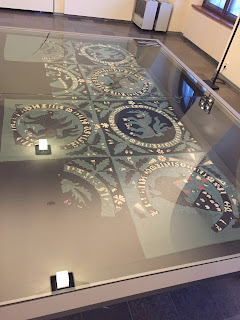My SCA persona's motto is AT SPES INFRACTA (Yet, hope is unbroken) and I have a thing for flying pigs and the idea of making the impossible possible. I was looking through Facebook memories this morning and in 2014 I had seen an advertisement for
Pig Wings, ribs that look like chicken wings. Rather than saying cool and moving one, my response was to go through a list of idioms of improbability and assign them dishes. This type of hyperbole taken to extreme lengths is called an adynata from the Greek
ἀδύνατον meaning both unable/ impossible and "to be powerful." It was a common Classical Period rhetorical device translated into Latin as impossibilia. It fits well with my ancient Greek name of Praxilla which gives me further reasons to adore the idea. It would even make a fabulous conceit for a sixteenth century Venetian salon. Thus, I'm putting it here so I don't lose it.
An impossible feast to be served with blue moon cocktails and presented on the Greek kalends (Kalends are Roman. . .).
When pigs fly: pork ribs shaped like wings, or bacon wrapped poultry
When it snows red snowflakes: Strawberries in snow would be a very historical option
When grapes/pears grow on the willow tree: Willow catkins can be mashed and eaten. Willow honey is a thing. Perhaps baked pears drizzled in willow honey? Grapes could also be iced and served in a willow basket. Or wine is always a possibility
When fish climb the poplar tree: Salmon smoked on poplar. Poplar is also a popular paper wood, so paperwrapped fish of some kind might be tasty.
When the moon turns to green cheese: Mmm, cheese wheel
If the sky falls we shall catch larks: Plenty of Roman lark recipes. Adapt to use chicken or game hen
When the calves are dancing on the ice: Perhaps some variant of steak tartare?
When cows fly: Should be as straightforward as the winged pigs
When salt glows: There are lots of lovely pink Himilayan salt lamps and plates. Something served on those.
Cold Hell: No idea what to make, but its a fabulous name for a dish
More idioms to play with:
When the cow goes on pilgrimage on its horns
when the flagpole blossoms
When the reed plant blossoms
When the apricot blooms
When poplars grow pears and willows wallflowers
When the crawfish whistles on the mountain and fish sing
A week with three Thursdays
When horses grow horns
When a horned cat walks by
When a beard grows in the palm of my hand
When frogs grow hair
When the owl's tail blooms
When the crow will fly upside down
Sooner the cactus grow on my palm
And just because it is so very, very specific to my persona and personal likes, this Bulgarian phrase has to be included:
koga se pokači svinja s z´´lti čehli na krusa (when the pig in yellow slippers climbs the pear tree





































